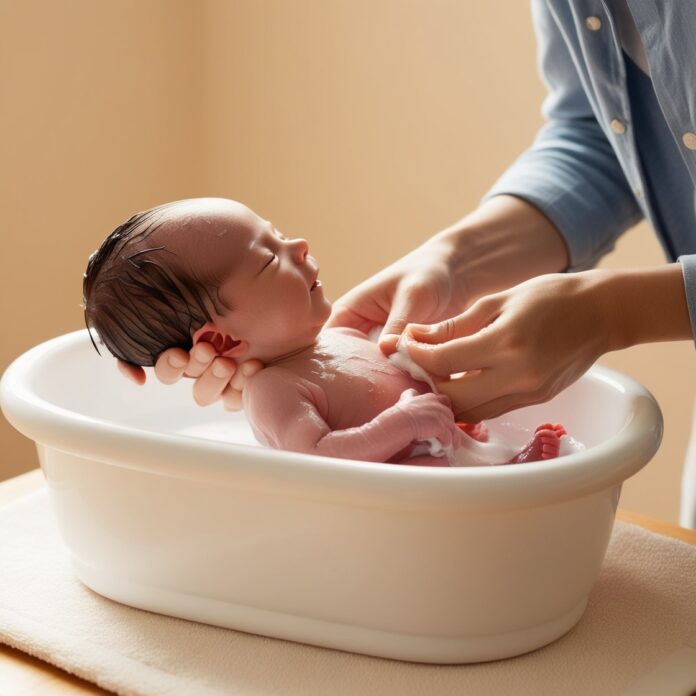Bathing your newborn can feel rather exciting and intimidating all at once, especially when it’s your first time around. Keeping your newborn bathed safely will keep him in comfort, health, and hygiene. This guide covers all the important do’s and don’ts to make sure you are confident with handling the daily routine.
How Often Should You Bathe Your Newborn?
During the first weeks of life, babies don’t need full baths. Usually, after birth, two to three sponge baths a week are enough until the stump falls off the umbilical cord. For the skin of the newborn, over-bathing often causes dryness. A wet cloth may be applied on the face, neck, and diaper area between baths.
Do’s for Bathing Your Newborn
1. Choose the Right Time
Choose a time when your baby isn’t starving or overtired. For many parents, a warm evening bath serves as a soothing end to the day and a wonderful bedtime routine.
2. Get Everything Ready Ahead of Time
Before you start, prepare all that you will be needing which includes a soft washcloth, baby soap, a cup to be used for rinsing, a clean towel, and a fresh diaper. This will ensure that everything is within easy reach so at all times you can have one hand on your baby.
3. Lukewarm Water
The water should be approximately 100°F (37.8°C), or warm, not hot. Always test the water temperature with your wrist or elbow first before carefully putting your baby in the tub. Keeping the water shallow, about two-inch deep helps ensure a safe and comfortable bath.
4. Support Your Baby at All Times
Always support your baby’s head and neck with one hand, since newborns have no muscle control. If using a sink or baby bath, put a non-slip mat in the bottom to prevent slipping.
5. Use Gentle, Fragrance-Free Products
Newborns have sensitive skin that tends to irritate easily; hence, mild fragrance-free soaps for babies should be used so that it may not irritate their skin. You need only a little soap, and you can wash it off by using lukewarm water.
Don’ts of Bathing Your Newborn
1. Never Leave Your Baby Alone
Never leave your baby alone in the bath, not even for one second. If you need to leave the bathroom, take your wrapped baby out with you.
2. Avoid Immersion of the Umbilical Cord Stump
Till the stump of the umbilical cord falls off, make it a point to keep the area around it dry, without letting it remain submerged in water. In general, resort to sponge baths and refrain from submerging your baby in water till the stump falls off. This will keep it dry and contribute to the process of healing.
3. Don’t Apply Much Soap
Too much soap will strip the baby’s skin of its natural oils. The baby should only be exposed to a small amount of mild soap in order for him/her to be safely and gently cleaned; cleansing should be done on areas that tend to get dirty, such as the diaper area and under the neck.
4. Avoid Hot Water and Keep the Room Warm
Keep the room warm and draft-free to reduce temperature fluctuation to which babies can be extremely sensitive. Cold air will make the bath experience quite unpleasant, while hot water is associated with the risk of burns.
5. Don’t Rub Your Baby’s Skin Too Hard
A newborn’s skin is sensitive, so wash and dry him using gentle strokes. For cleaning, a soft washcloth can be used while you can pat your baby dry using a soft towel, paying more attention to the face and sensitive areas.
Step-by-Step Guide to Bathing Your Newborn
Step 1: Sponge Baths for Newborns
For the first few weeks, bathe your baby using only sponge baths. Dip the washcloth in warm water and wring it out, then gently wash your baby’s face, neck, and diaper area. Be very gentle around the eyes and ears, using a clean part of the cloth for each area to avoid spreading infection.
Step 2: Move Your Baby to a Tub Bath
When the stump of the umbilical cord falls off, you may switch to a tub bath. Fill the baby tub with a few inches of lukewarm water and gently lower your baby into it, supporting his head and neck.
Step 3: Clean from top to bottom
First, clean the baby’s head, taking care not to touch the fontanel. Next, wash the body, paying special attention to the folds in the neck, behind the ears, and also between the fingers and toes. At all times, leave one hand on the baby for support.
Step 4: Rinse and Dry
Rinse your baby’s skin with clean, warm water from the cup. After the bath, wrap your baby in a soft, hooded towel and pat dry, paying extra attention to folds in the skin to prevent irritation.
Helpful Newborn Bathing Tips
1. Prepare a Comfortable Atmosphere
She will relax if she enjoys her bath time. In fact, the room should be at a very warm temperature. You can play soft music or use any soothing talk with your baby while she is in the bath.
2. Buy a Bath Support
If you are nervous about handling a slippery newborn, you may want to buy a bath support or insert that goes into the baby tub. These supports allow the baby to be in comfortable and safe positions.
3. Apply Baby Moisturizer after Bathing
Smear a light, fragrance-free baby lotion on your baby after drying to lock the moisture. Fragrance-free and hypoallergenic lotions are just perfect for sensitive skin.
Bathing your newborn can be one of those pleasurable bonding experiences. Keeping in mind the following do’s and don’ts will keep your baby safe and comfortable during bath time. Remember, every baby is different, and it may take a few baths to find a routine that works best for you and your little one.



